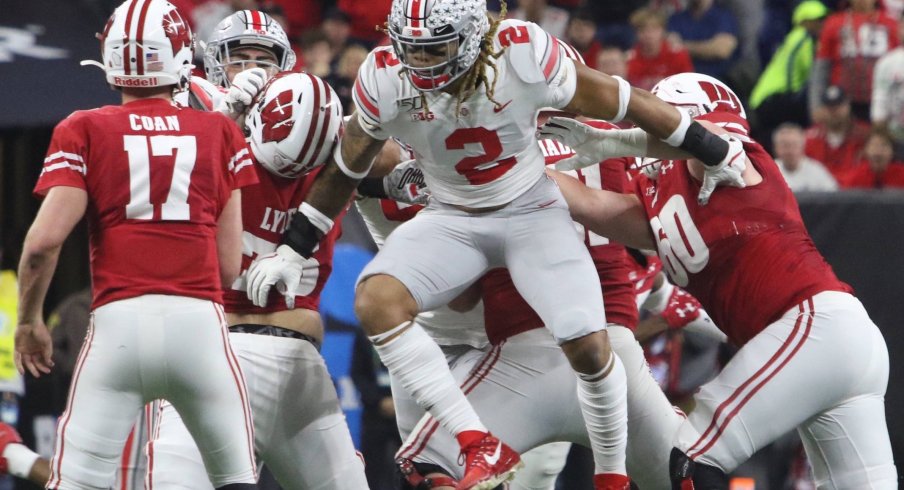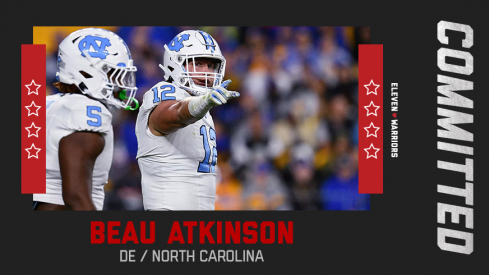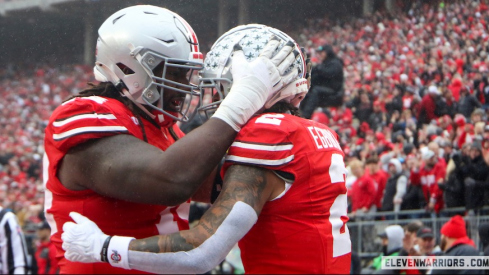Quinshon Judkins is staying in Ohio, as the Cleveland Browns select him with the No. 36 overall pick.
Now is a time for reflection.
With the sporting calendar stopped cold in its tracks and millions of Americans sitting at home with little to do or watch, it's only natural to look back on the good times, even if they seem like the distant past. It's hard to believe that it's only been a couple of months since the Ohio State Buckeyes last stepped onto the field, bringing two Heisman finalists to a contest that will be remembered for years to come.
But although the threat of the Coronavirus has brought people together in new and unexpected ways, cutting through the angst and rising to the unforeseen challenges we're facing on a daily basis, we mustn't forget who we are as a sports-loving society.
One of the bedrock principles of this culture is NFL draft analysts telling college football fans their favorite player isn't actually as #Elite as they think, sparking outrage and debate within passionate fanbases which just so happen to drive clicks and video views. Given everything happening in recent times, it's understandable that you might have missed the patron saint of mock drafts himself making such a claim.
“Chase Young didn’t finish strong,” Mel Kiper Jr. said during a February 28th appearance on ESPN's Get Up. “The last three games, he didn’t have a sack. He was not a game-breaker. Had he been, I contend that he could have been in the discussion for the Bengals. How can you pass on this guy who had a couple sacks in each of the last three games or was out there dominating. But he didn’t."
It's true that the nation's leader in sacks didn't register a single one during the Buckeyes' final three contests, a gauntlet of top-20 opponents which came to define their season. It's also true that those came following an absurd stretch in which Young bookended a two-game suspension with 7 combined sacks against Wisconsin and Penn State, leaving many to wonder if the NCAA single-season record of 24 was in jeopardy, yet only to see him finish with just 16.5.
But to act as though Young wasn't an impact player in the three biggest games of Ohio State's season is not just unfair, it's simply incorrect. In this instance, the traditional box score doesn't tell the full story.
While Young only tallied five tackles during this stretch, 1.5 of which were for-loss, he did still register two passes-broken-up and five QB hurries. Many of those statistics came when the junior defensive had the rare chance to beat his blocker in a fair, one-on-one contest.
These occasions were rare, though, as all three opponents made clear efforts to minimize his impact by giving him extra attention.
Wisconsin, especially, made sure to know where he was at all times after he ruined their game plan when the two teams met on a rainy October Saturday. In their December rematch, Young often saw Slide protection sent his way, ensuring the tackle could cheat outside knowing he had help inside from the guard next to him.
But the Badgers occasionally went a step further, assigning the running back to help outside, creating a three-on-one situation. That attention meant the three remaining Buckeye rushers each faced solo protection, meaning it was only a matter of 'when' not 'if' they would reach the passer.
The Buckeye coaching staff clearly took note of such efforts and were surely happy to see their opponents over-extend themselves just to slow down one of their eleven defenders. Despite Young's stunted statistics, the unit performed well overall, totaling seven sacks, seven QB hurries, and 20 broken-up passes in the final three games as Young drew the attention of opposing offenses.
But the OSU coaches did still try to free up Young to make plays.
One way to defeat the Slide protection was by sending a linebacker blitzing through the B-gap inside of him. This forces the guard to pick up the extra rusher and leaves the tackle one-on-one against Young, resulting in this disrupted throw.
The Buckeyes also used different fronts to create space pre-snap.
Though the Buckeyes were in a 4-2-5 nickel personnel package below, they lined up the WILL linebacker directly over the center with both offensive tackles covered by their defensive counterparts, creating an odd front. As those DTs slanted into the A-gaps, pulling the guards inside, Young was left all alone against a tackle, forcing a quick throw with an inside move before the receiver had even turned to look for the ball.
These efforts to free up Young extended to the running game as well.
The Badgers often attempted to simply overpower the 265lb end by running straight at him, hoping to use 313lb Cole Van Lanen (#71) as a road-grader. But Young's quickness proved too much, as he still plugged run gaps effectively thanks to gap-exchanges.
With the WILL 'backer lined up over the B-gap between the guard and tackle and Young aligned in the C-gap outside it, one would assume they'd each be responsible for their nearest running lane. At the snap, however, Young darts inside to take away the B-gap while the WILL steps up immediately to fill the C, leaving the blockers in disarray and resulting in only a minimal gain.
In the Fiesta Bowl, Young's biggest impact came thanks to his mere presence. Lined up most often as the strong-side DE in front of SAM linebacker Pete Werner, the Tigers could accurately predict where he'd line up by using their own formations to dictate the defense's alignment.
From there, the Tigers simply ran away from the All-American, running nearly every time in the direction of true freshman Zach Harrison, who started the game at weakside end as multiple upperclassmen were out due to injury. After halftime, however, Young began changing his alignment, swapping roles to play the weakside spot.
The Tigers have long been an option-based run game, and QB Trevor Lawrence's legs proved to be a big factor in the contest's outcome. But when Young was finally moved to the weakside position where Harrison was expected to be, the option game didn't quite work as planned.
While Kiper never truly backed down from his #take, his story shifted to the age-old argument of the value of a franchise quarterback. In subsequent interviews, the well-coiffed critic defended his prediction of Tua Tagovailoa going second overall to Washington in this year's draft (instead of Young, the hometown product of the DMV) by saying that the passer is more critical to a team's success than the guys trying to bring him down.
“You’ve gotta get the quarterback,” Kiper said. “You can have Chase Young and three other Chase Youngs. The 49ers, did they win the Super Bowl? No. (Patrick) Mahomes did — the better quarterback.”
Such logic is far more sound and believable than his original claim. But it will have to wait for another day, as the debate over replacing the current QB in D.C. with Tagovailoa after only one season will just bring us all back to the same table.



